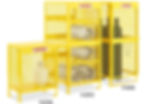LP Gas Cylinder Storage Requirements
- May 13, 2021
- 4 min read
Updated: Feb 24, 2022
May 14, 2021 // THIS WEEK'S TOPIC: How to store LP Gas safely.

What is “LP gas?”
The “LP” stands for "liquefied petroleum." A widely used fuel, LP gas is a mixture of light hydrocarbons, predominantly any of the following or mixtures of them; propane, propylene, butanes and butylenes, which are gaseous at atmospheric pressure and temperature. Because of its absence of sulfur and its very low production of nitrogen oxides (NOx), this fuel produces low levels of toxic substances and particulates during combustion. NOx emissions are nitric oxides and nitrogen dioxides. LP gas can be easily liquefied by modestly decreasing the temperature or increasing the pressure. This makes it extremely easy to store and transport, even to remote areas.
The Occupational Safety and Health Administration (OSHA) addresses the storage and handling of LP gas in 29 Code of Federal Regulations (CFR) 1910.110.The National Fire Protection Association (NFPA) standard on LP gas, NFPA 58 Liquefied Petroleum Gas Code, covers the storage, handling, transportation, and use of LP gas.
This document focuses on the proper storage and use of portable LP gas containers - cylinders of 1,000-pounds water capacity or less at user locations – as outlined by OSHA and the NFPA.
The most common type of LP Gas container is the propane cylinder, commonly referred to as a “bottle.” Most of us are familiar with the propane bottles used to fuel gas grills, but instrument grade LP Gas such as butane, propane and isobutane are becoming much more common in the extraction industry.
LP Gas Cylinders Specifications
All LP gas cylinders have the same operational and safety mechanisms in place. These include:
Relief valves
Service valves
Bleeder valves
Stamped markings or nameplates
Protective collars / neck rings
Foot rings
The valves on LP gas cylinders must be protected by a protective cap or collar, also called a neck ring. An unprotected valve hit hard enough can break off allowing liquid gas to escape at a dangerously fast rate. The escaping gas can act as propulsion for the cylinder allowing it to become a dangerous projectile.
The bottom of all propane cylinders are required to have a foot ring. The foot ring ensures that the cylinder stands in an upright and level position. Most LP gas cylinders are made of steel and therefore they are subject to rusting. The most common place rust is found is on the bottom of the cylinder and around the foot ring. It is important to keep those areas clean and dry. This is why at Solvent Direct we use 3 Phase Decontamination Cleanings before every refill to prevent corrosion and toxic petroleum waste accumulations inside the cylinder.

Storage and Use
OSHA and NFPA guidelines for storing and using LP gas:
Minimize exposure to excessive temperature rise, physical damage or tampering - store cylinders in an open-air storage unit or cage with a protective roof overhead
Use and store cylinders in the proper position
Store cylinders with the relief valve in direct contact with the vapor space in the container
Cylinders used for forklifts can be stored in either the vertical or horizontal position, but if stored horizontally the relief valve must be positioned at 12 o’clock
Cylinder valves must be protected - screw-on type caps or collars must be securely in place on all stored cylinders regardless of whether they are full, partially full or empty, and container outlet valves must be closed
Storage locations must be provided with at least one approved portable B:C rated fire extinguisher
The required fire extinguisher must be located no more than 50-feet from the storage location.
Other sources of information regarding storage of LP gas cylinders can be obtained from OSHA Standard 29 CFR 1910.101 which covers general requirements regarding compressed gases. It refers to the Compressed Gas Association’s (CGA) Pamphlet P-1– Standard for Safe Handling of Compressed Gases in Containers, which was last updated in 2015. Additional information is available in Quick Tips #136: Gas Cylinder Storage and Handling. And remember, it is always important to check state and local codes and with the local authority having jurisdiction (AHJ).

LP Gas Cylinder Cabinet. Please give us a call or text at 1-833-PURE-GAS or 1-833-787-3427 to learn more or place an order.
Commonly Asked Questions
Q: Is there a source that outlines distance requirements for proper outside storage of LP gas cylinders? A: Yes, both 29 CFR 1910.110 Table H-33 and NFPA 58 Table 8.4.1 outline distance requirements from buildings, property lines, busy thoroughfares, sidewalks and other points of adjoining public gathering points. Q: When was NFPA 58 standard first adopted? A: The first NFPA standard on LP gas was adopted in 1932 and it has been revised 38 times since then. The latest edition (2017) was issued on August 4, 2016 and became effective on August 24, 2016. It supersedes all previous editions.
Sources
The information contained in this article is intended for general information purposes only and is based on information available as of the initial date of publication. No representation is made that the information or references are complete or remain current. This article is not a substitute for review of current applicable government regulations, industry standards, or other standards specific to your business and/or activities and should not be construed as legal advice or opinion. Readers with specific questions should refer to the applicable standards or consult with an attorney.




